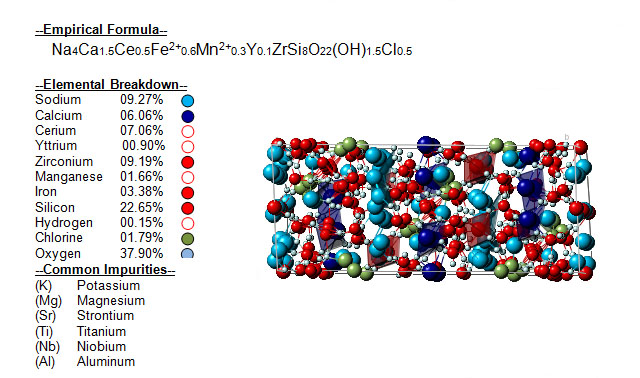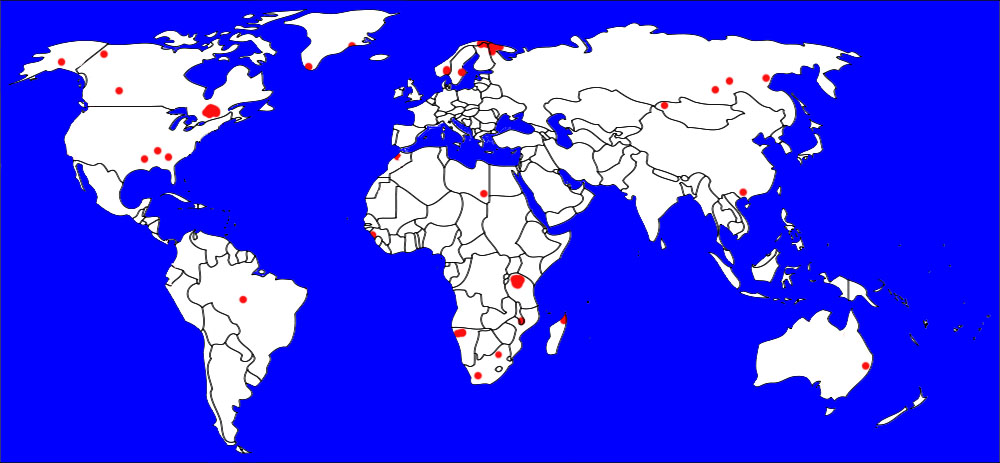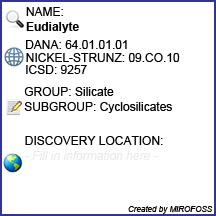

| Mineral Name | Eudialyte |
| First Discovered | 1819 |
| Nickel-Strunz Classification | 09.CO.10 |
| Dana Classification | 64.01.01.01 |
| ICSD | 9257 |
| Mineral Group | Silicates |

| Cleavage | Imperfect |
| Colour(s) | Pinkish red, Red, Yellow, Yellowish brown, Violet |
| Specific Gravity | 2.9 |
| Diaphaneity | Transparent to Translucent |
| Fracture | Uneven - Flat surfaces (not cleavage) fractured in an uneven pattern |
| Mohs Hardness | 5.0 to 5.5 |
| Luminescence | Non-fluorescent |
| Luster | Vitreous |
| Streak | White |
| Habit(s) | Massive to Granular to Tabular |
| Radioactivity | Eudialyte per GRapi unit = 137.21 (PPM) |
| Magnetism | Non-magnetic |

The following health hazards should be noted when handling eudialyte
 |
RADIOACTIVE Eudialyte is radioactive as defined in section 49 CFR 173.403. Greater than 70 Bq / gram. |

The following image shows the Elemental breakdown of the mineral eudialyte along with the mineral crystal structure.


| Crystal System | Trigonal |  |
| Class | Hexagonal | |
| Axial Ratios | a : c = 1 : 2.10669 | |
| Morphology | short rhombohedral to long prismatic | |
| Optical Data Type | Uniaxial (+/-) | |
| Dichroism (e) | N/A | |
| Dichroism (w) | N/A | |
| Pleochroism (z) | None | |
| RL Values | nω = 1.606 - 1.610 nε = 1.610 - 1.613 |  |
| 2V | N/A | |
| Max Birefringence | δ = 0.004 (See colour chart at right) | |
| Surface Relief | Moderate | |
| Pleochroism | Weak |

Eudialyte can be referenced in certain current and historical texts under the following five names:
The mineral eudialyte can be translated into the following select languages:
| Arabic | Bulgarian | Chinese (Sim) | |||
| Croatian | Czech | Danish | eudialyt | ||
| Dutch | Eudialyt | Esperanto | Estonian | eudialiit | |
| Finnish | French | German | Eudialyt | ||
| Greek | Hebrew | Hungarian | |||
| Italian | Japanese | ユージアライト | Korean | 유마일라읻으 | |
| Latin | Lithuanian | Norwegian | |||
| Persian | Polish | Portuguese | |||
| Romanian | Russian | Эвдиалит | Slovak | ||
| Spanish | Eudalita | Swedish | eudialyt | Tagalog | |
| Turkish | Ukrainian | Евдіалітia | Vietnamese |

Eudialyte can be found in a few places around the world. The map below shows major documented concentrations of eudialyte:


 |
The MIROFOSS database offers free printable geological identification tags for personal and non-profit use. These tags can be used to properly identify mineral samples in your collection. -Click here- to download a full size jpeg image for a eudialyte identification tag; which can be printed on paper or used with a plastic laser printer. |
 |
What's this? What can I do with it? |

| Crystallography | Khomyakov, A.P., Nechelyustov, G.N., Rastsvetaeva, R.K. (2007): Aqualite, (H3O)8(Na,K,Sr)5Ca6Zr3Si26O66(OH)9Cl, a new eudialyte-group mineral from Inagli alkaline massif (Sakha-Yakutia,Russia),and the problem of oxonium in hydrated eudialytes. Proceedings of the Russian Mineralogical Society (Zapiski RMO), 136(2), 39-55. |
| History | Canadian Mineralogist (1999): 37: 865-891. |
| Chemical Composition | Johnsen, O. and Galt, R.A. (1997) Chemical variation in eudialyte. Neues Jahrbuch für Mineralogie, Abhandlungen: 171: 215-237. |
| Geographical Data | Mindat.org. Retrieved on 2012-11-01 |
| Physical Identification | Webmineral.com. Retrieved on 2012-11-01 |
| November 01, 2012 | The last time this page was updated |
| ©2017 MIROFOSS™ Foundation | |
 |